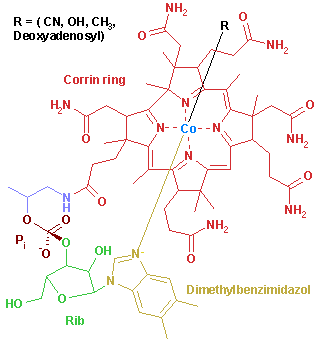In some patients with Vitamin B-12 deficiency mistakenly treated with folic acid, anemia resolved but neurologic complications became worse. This phenomenon, known as masking of vitamin B-12 deficiency, has never been studied systematically for the obvious reason that patients would never knowingly be given the wrong treatment, particularly when the neurologic damage associated with vitamin B-12 deficiency is often irreversible. Therefore, little is known about how frequently masking occurs and of the lowest dose of folic acid that produces masking.
Fortification of enriched cereal grains with folic acid has raised concerns that people who consume large quantities of cereal grains, particularly the elderly, may be at increased risk of masking. Therefore, this study was designed to identify patients with low vitamin B-12 before and after most grain products were fortified with folic acid to determine whether the proportion of cases occurring without anemia increased after fortification.
The laboratory results of every patient for whom a vitamin B-12 level was measured at the Veterans Affairs Medical Center in Washington, DC, between 1992 and 2000, were reviewed. Vitamin B-12 concentrations < 258 pmol/L were considered low since this concentration has been shown to correlate well with vitamin B-12 deficiency. Those with a low vitamin B-12 concentrations had their hematocrits and mean cell volumes checked. The proportion without anemia was examined by year before, during and after folic acid fortification began. Fortification was required by January 1, 1998; however, the industry has the option of fortifying anytime after March 5, 1996.
There were 1573 subjects with a low vitamin B-12 concentration. The proportion of subjects without anemia was 39.2% before fortification, 45.5% during the option period of fortification, and 37.6% after fortification was completely implemented. The proportion did not change significantly over the three time periods. These findings did not change when the analysis was limited to patients older than 60 or when a more conservation definition of low vitamin B-12 (< 150 pmol/L) was used.
The findings showed that there was no evidence of an increase in low vitamin B-12 concentrations without anemia. Therefore, the amount of folic acid currently being added to food is not causing a major increase in masking of vitamin B-12 deficiency anemia. Mills et al. acknowledge that the population seeking care at the study facility could have changed over the course of the study. Another limitation was that the subjects were mainly African American and were not a representative sample of the US population. However, the major strengths of the study include the large number of subjects available for investigation and the stable referral pattern. It has also been shown that the actual amount of folic acid being added to food is > 50% more than that called for in the US FDA regulations. Despite this dramatic increase in folic acid, the results again show that food fortification has not caused an increase in vitamin B-12 deficiency masking.
James L Mills, Isabelle Von Kohorn, Mary R Conley, et al., Low Vitamin B-12 Concentrations in patients without anemia: the effect of folio acid fortification of grain, Am J Clin Nutr 77:1474-1477 (dune 2003) [Address reprint requests to JL Mills, Pediatric Epidemiology Section, Division of Epidemiology, Statistics and Prevention Research, 6100 Building, Room 7B03, NICHD, NIH, DHHS, Bethesda, MD 20892. E-mail: jamesmills@nih.gov]
COPYRIGHT 2003 Frost & Sullivan
COPYRIGHT 2003 Gale Group



